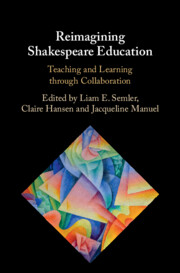Book contents
- Reimagining Shakespeare Education
- Reimagining Shakespeare Education
- Copyright page
- Dedication
- Contents
- Figures
- Tables
- Notes on Contributors
- Acknowledgements
- Introduction
- Part I Reimagining Shakespeare with/in Schools
- Part II Reimagining Shakespeare with/in Universities
- Part III Public Reimaginings
- Part IV Digital Reimaginings
- Part V Reimagining Performance
- Afterword
- Index
- References
Introduction
Projecting Shakespeare
Published online by Cambridge University Press: 02 February 2023
- Reimagining Shakespeare Education
- Reimagining Shakespeare Education
- Copyright page
- Dedication
- Contents
- Figures
- Tables
- Notes on Contributors
- Acknowledgements
- Introduction
- Part I Reimagining Shakespeare with/in Schools
- Part II Reimagining Shakespeare with/in Universities
- Part III Public Reimaginings
- Part IV Digital Reimaginings
- Part V Reimagining Performance
- Afterword
- Index
- References
Summary
Shakespeare education is being reimagined around the world. This book delves into the important role of collaborative projects in this extraordinary transformation. Over twenty innovative Shakespeare partnerships from the United Kingdom, the United States, Australia, New Zealand, the Middle East, Europe and South America are critically explored by their leaders and participants. Structured into thematic sections covering engagement with schools, universities, the public, the digital and performance, this book offers vivid insights into what it means to teach, learn and experience Shakespeare in collaboration with others. Diversity, equality, identity, incarceration, disability, community and culture are key factors in these initiatives, which together reveal how complex and humane Shakespeare education can be. Whether you are interested in practice or theory, this collection showcases an abundance of rich, inspiring and informative perspectives on Shakespeare education in our contemporary world.
- Type
- Chapter
- Information
- Reimagining Shakespeare EducationTeaching and Learning through Collaboration, pp. 1 - 20Publisher: Cambridge University PressPrint publication year: 2023

